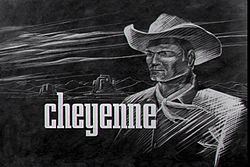Cheyenne: Reviewing the Classic Western

1950s Television
Westerns were making a huge splash in the 1950s. As each network took part to bring their adventure to new heights some shows faded out of sight. Uncertainty prevails as to why some perish and others flourish for year after year. One thing for certain is clear. If ratings soar the show goes on to live another season. Introducing a western drama in the 1950s most likely would be a great hit as their popularity grew.
Part of an Anthology Series
Tricks of the trade in television sometimes meant scheming ideas to launch one show against another in a weekly presentation. The strong series may drown out its underdog brother and demand more air time leaving its sibling erased from view. The big brother getting the attention for this review shared air time more than once with shows it dominated.
In 1955, on ABC, an anthology series called Warner Brothers Presents set out to introduce three series to be run alternately with each playing on the same time slot. It introduced Cheyenne, starring Clint Walker as the first hour long western drama, a long side two other shows, King Row starring Jack Kelly and Robert Horton lasted only a few weeks and Casablanca starring Charles McGraw followed suit with cancelation before the season ended.
The name Warner Brothers Presents was changed to Conflict toward the end of 1955 and remained through 1956. Cheyenne took the spotlight by itself until 1957 when it ran alternately with a show called Sugarfoot starring Will Hutchinson. In 1958 a new show was run off from Cheyenne called Bronco starring Ty Hardin because Bronco was a fill in on the Cheyenne series when Clint Walker left the show for a short period of time. This meant three different shows were running alternately once again. Known as The Cheyenne Show, Cheyenne shared its air time until 1963 when it ran alone. Cheyenne ran 108 episodes from 1955-1963.
Cheyenne
A long tall drink of water as the western cowboys would say, Cheyenne Bodie (Clint Walker) took his first name from the tribe who raised him after killing his parents until he was twelve. He later found a frontier family to take him in. He stayed friendly with the Cheyenne tribe and encountered their present from time to time. Cheyenne was a drifter traveling the west in the era following the civil war. He tried all fairness to resolve problems faced on his journey. As bad guys and drama gave way as he wondered through western territory, many people looked to him with his strength to protect them. He acquired different jobs along his travels and was well suited for each one. Cheyenne became an adventure which brought excitement to the people it entertained. No need to say why it out lasted the other series it was bundled with because an audience knows what it wants to see.
Decades later the reruns astonish even the most hard to please western lover and given the comeback as more channels are enticed to air the classic westerns, Cheyenne will be enjoyed for generations to come. Ladies love the character for his masculine build, good looks and charming personality. Men are amused by the action and tough man image he portrays. The classic westerns were family oriented for children to enjoy the drama and let their imaginations go wild putting them in the saddle with their hero. Cheyenne serves well its general audience even though it was an adult western. Not the sort of thing one would expect of an adult western to be at today’s standards. Values and lessons learned were left to the classic westerns of yesterday.
Check out Clint Walker’s Website and join him on Facebook.com as you treat yourself to a blast from the past cowboy style.
Cheyenne
MAYBE IT'S THE COWBOYS
- MAYBE ITS THE COWBOYS
Westerns were my dad's favorite shows when it came to entertainment. This is a memorial poem for my dad. His interest is still very much alive in me as I love to watch the old classic westerns, too. I've also added links to reviews I've written about








